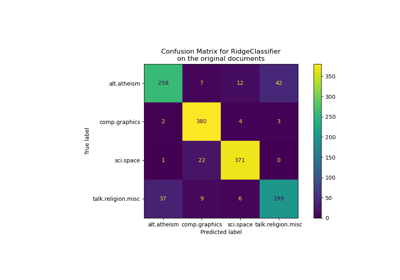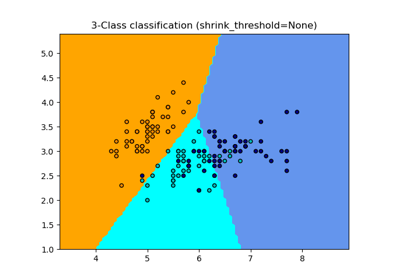NearestCentroid#
- class sklearn.neighbors.NearestCentroid(metric='euclidean', *, shrink_threshold=None, priors='uniform')[source]#
Nearest centroid classifier.
Each class is represented by its centroid, with test samples classified to the class with the nearest centroid.
Read more in the User Guide.
- Parameters:
- metric{“euclidean”, “manhattan”}, default=”euclidean”
Metric to use for distance computation.
If
metric="euclidean", the centroid for the samples corresponding to each class is the arithmetic mean, which minimizes the sum of squared L1 distances. Ifmetric="manhattan", the centroid is the feature-wise median, which minimizes the sum of L1 distances.Changed in version 1.5: All metrics but
"euclidean"and"manhattan"were deprecated and now raise an error.Changed in version 0.19:
metric='precomputed'was deprecated and now raises an error- shrink_thresholdfloat, default=None
Threshold for shrinking centroids to remove features.
- priors{“uniform”, “empirical”} or array-like of shape (n_classes,), default=”uniform”
The class prior probabilities. By default, the class proportions are inferred from the training data.
Added in version 1.6.
- Attributes:
- centroids_array-like of shape (n_classes, n_features)
Centroid of each class.
- classes_array of shape (n_classes,)
The unique classes labels.
- n_features_in_int
Number of features seen during fit.
Added in version 0.24.
- feature_names_in_ndarray of shape (
n_features_in_,) Names of features seen during fit. Defined only when
Xhas feature names that are all strings.Added in version 1.0.
- deviations_ndarray of shape (n_classes, n_features)
Deviations (or shrinkages) of the centroids of each class from the overall centroid. Equal to eq. (18.4) if
shrink_threshold=None, else (18.5) p. 653 of [2]. Can be used to identify features used for classification.Added in version 1.6.
- within_class_std_dev_ndarray of shape (n_features,)
Pooled or within-class standard deviation of input data.
Added in version 1.6.
- class_prior_ndarray of shape (n_classes,)
The class prior probabilities.
Added in version 1.6.
See also
KNeighborsClassifierNearest neighbors classifier.
Notes
When used for text classification with tf-idf vectors, this classifier is also known as the Rocchio classifier.
References
[1] Tibshirani, R., Hastie, T., Narasimhan, B., & Chu, G. (2002). Diagnosis of multiple cancer types by shrunken centroids of gene expression. Proceedings of the National Academy of Sciences of the United States of America, 99(10), 6567-6572. The National Academy of Sciences.
[2] Hastie, T., Tibshirani, R., Friedman, J. (2009). The Elements of Statistical Learning Data Mining, Inference, and Prediction. 2nd Edition. New York, Springer.
Examples
>>> from sklearn.neighbors import NearestCentroid >>> import numpy as np >>> X = np.array([[-1, -1], [-2, -1], [-3, -2], [1, 1], [2, 1], [3, 2]]) >>> y = np.array([1, 1, 1, 2, 2, 2]) >>> clf = NearestCentroid() >>> clf.fit(X, y) NearestCentroid() >>> print(clf.predict([[-0.8, -1]])) [1]
- decision_function(X)[source]#
Apply decision function to an array of samples.
- Parameters:
- X{array-like, sparse matrix} of shape (n_samples, n_features)
Array of samples (test vectors).
- Returns:
- y_scoresndarray of shape (n_samples,) or (n_samples, n_classes)
Decision function values related to each class, per sample. In the two-class case, the shape is
(n_samples,), giving the log likelihood ratio of the positive class.
- fit(X, y)[source]#
Fit the NearestCentroid model according to the given training data.
- Parameters:
- X{array-like, sparse matrix} of shape (n_samples, n_features)
Training vector, where
n_samplesis the number of samples andn_featuresis the number of features. Note that centroid shrinking cannot be used with sparse matrices.- yarray-like of shape (n_samples,)
Target values.
- Returns:
- selfobject
Fitted estimator.
- get_metadata_routing()[source]#
Get metadata routing of this object.
Please check User Guide on how the routing mechanism works.
- Returns:
- routingMetadataRequest
A
MetadataRequestencapsulating routing information.
- get_params(deep=True)[source]#
Get parameters for this estimator.
- Parameters:
- deepbool, default=True
If True, will return the parameters for this estimator and contained subobjects that are estimators.
- Returns:
- paramsdict
Parameter names mapped to their values.
- predict(X)[source]#
Perform classification on an array of test vectors
X.The predicted class
Cfor each sample inXis returned.- Parameters:
- X{array-like, sparse matrix} of shape (n_samples, n_features)
Input data.
- Returns:
- y_predndarray of shape (n_samples,)
The predicted classes.
- predict_log_proba(X)[source]#
Estimate log class probabilities.
- Parameters:
- X{array-like, sparse matrix} of shape (n_samples, n_features)
Input data.
- Returns:
- y_log_probandarray of shape (n_samples, n_classes)
Estimated log probabilities.
- predict_proba(X)[source]#
Estimate class probabilities.
- Parameters:
- X{array-like, sparse matrix} of shape (n_samples, n_features)
Input data.
- Returns:
- y_probandarray of shape (n_samples, n_classes)
Probability estimate of the sample for each class in the model, where classes are ordered as they are in
self.classes_.
- score(X, y, sample_weight=None)[source]#
Return accuracy on provided data and labels.
In multi-label classification, this is the subset accuracy which is a harsh metric since you require for each sample that each label set be correctly predicted.
- Parameters:
- Xarray-like of shape (n_samples, n_features)
Test samples.
- yarray-like of shape (n_samples,) or (n_samples, n_outputs)
True labels for
X.- sample_weightarray-like of shape (n_samples,), default=None
Sample weights.
- Returns:
- scorefloat
Mean accuracy of
self.predict(X)w.r.t.y.
- set_params(**params)[source]#
Set the parameters of this estimator.
The method works on simple estimators as well as on nested objects (such as
Pipeline). The latter have parameters of the form<component>__<parameter>so that it’s possible to update each component of a nested object.- Parameters:
- **paramsdict
Estimator parameters.
- Returns:
- selfestimator instance
Estimator instance.
- set_score_request(*, sample_weight: bool | None | str = '$UNCHANGED$') NearestCentroid[source]#
Configure whether metadata should be requested to be passed to the
scoremethod.Note that this method is only relevant when this estimator is used as a sub-estimator within a meta-estimator and metadata routing is enabled with
enable_metadata_routing=True(seesklearn.set_config). Please check the User Guide on how the routing mechanism works.The options for each parameter are:
True: metadata is requested, and passed toscoreif provided. The request is ignored if metadata is not provided.False: metadata is not requested and the meta-estimator will not pass it toscore.None: metadata is not requested, and the meta-estimator will raise an error if the user provides it.str: metadata should be passed to the meta-estimator with this given alias instead of the original name.
The default (
sklearn.utils.metadata_routing.UNCHANGED) retains the existing request. This allows you to change the request for some parameters and not others.Added in version 1.3.
- Parameters:
- sample_weightstr, True, False, or None, default=sklearn.utils.metadata_routing.UNCHANGED
Metadata routing for
sample_weightparameter inscore.
- Returns:
- selfobject
The updated object.
Gallery examples#

Classification of text documents using sparse features
